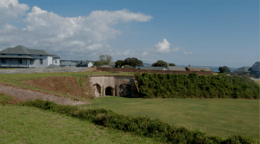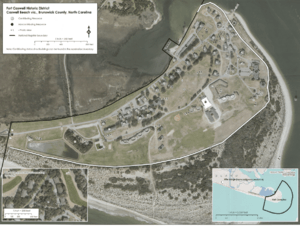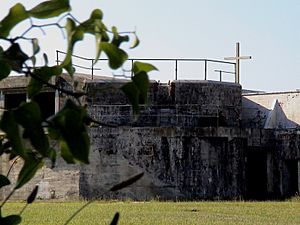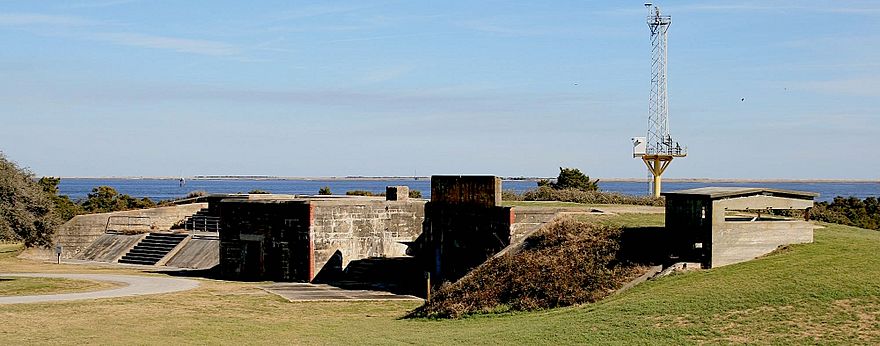Fort Caswell Historic District facts for kids
Quick facts for kids |
|
|
Fort Caswell Historic District
|
|

Original Fort Caswell
|
|
| Location | 100 Caswell Beach Road, near Caswell Beach, North Carolina |
|---|---|
| Area | 760 acres (310 ha) |
| Built | 1838, 1898-ca. 1941 |
| Built by | U.S. Army Quartermaster Corps; Bernard, Simon |
| Architectural style | Colonial Revival, Queen Anne |
| NRHP reference No. | 13001025 |
| Added to NRHP | December 31, 2013 |
Fort Caswell is a historic place in North Carolina. It's located right on the Atlantic Coast. This area includes 2 sites, 43 buildings, and 23 other structures. It was added to the National Register of Historic Places in 2013.
The fort itself was used by the U.S. armed forces for many years. This was mostly between 1836 and 1945. Today, Fort Caswell is part of the North Carolina Baptist Assembly. This is a Christian retreat center. It is owned and run by the Baptist State Convention of NC. You can visit some parts of the fort, but there are certain rules set by the Assembly’s Director.
Where is Fort Caswell?
Fort Caswell is located on the eastern tip of Oak Island. This is in Brunswick County, NC. The fort sticks out into the water where the Cape Fear River meets the Atlantic Ocean.
The historic area also reaches out into the ocean and the Cape Fear River. This is because of its connection to the American Civil War. During the war, ships called blockade runners used this area. Also, the fort helped hunt German submarines in World War II.
A rifle range site is located about two miles west of the fort. It is in the town of Caswell Beach. The land here is mostly flat, like other coastal areas in southeastern North Carolina. It's about ten feet above sea level. There's a wide sandy beach along its southern edge. Most of the area is covered in grass. You can also see many Yaupon Holly and Live Oak trees.
Fort Caswell's History
Fort Caswell was named after former governor Richard Caswell. The first fort was shaped like a pentagon. It had strong brick walls and large earthworks (mounds of earth). It was finished in 1836 and cost a lot of money.
The fort had over 61 gun positions. Its job was to protect the mouth of the Cape Fear River. This was important for defending Wilmington. Wilmington was a major port city about 20 miles upriver. At that time, it was North Carolina's largest city.
Civil War Role
In 1861, a group called the "Cape Fear Minutemen" took control of the fort twice. The governor, John Willis Ellis, ordered them to give it back. At that time, only one man from the U.S. Army was stationed there.
When North Carolina left the Union, the new Confederate Army took over. They made Fort Caswell and nearby Fort Fisher part of a very strong defense system. Fort Fisher guarded the other entrance to the Cape Fear River. This system, along with fast blockade runners, kept Wilmington's port open longer than any other Confederate port.
Many plans were made to capture Fort Caswell. But its strong defenses and the dangerous Frying Pan Shoals offshore stopped them. The Union Army then focused on Fort Fisher. After the Union captured Fort Fisher on January 15, 1865, orders came for Fort Caswell. The soldiers were told to disable the guns, burn the barracks, and blow up the ammunition storage areas (magazines).
On January 17, the magazines were blown up. About 100,000 pounds of gunpowder exploded! People at the time said the blast could be heard 100 miles away in Fayetteville. One whole wall of the fort was destroyed by the explosion. Losing Wilmington, the Confederacy's last major port, was a big reason why Robert E. Lee decided to surrender at Appomattox.
After the Civil War
In the 1890s, the U.S. Army built a full military base at the site. They added coastal artillery batteries. Most of the buildings you see today, and the sea wall, were built during this time.
During World War I, Fort Caswell was used as an army training facility. This included the separate Fort Caswell Rifle Range. In 2020, a book with pictures and stories about the rifle range and Brunswick County veterans from World War I became available.
After World War I, the fort was left empty. From 1937 to 1941, people tried to turn it into a resort. They even used the old gun positions as swimming pools! Hot mineral water from two artesian wells filled the pools. But the resort didn't work out.
In 1941, the Navy bought the fort. They used it as a patrol and anti-submarine base during World War II. After the war, in 1949, the Baptist State Convention of North Carolina bought the property for $86,000. They turned it into the retreat center it is today.








